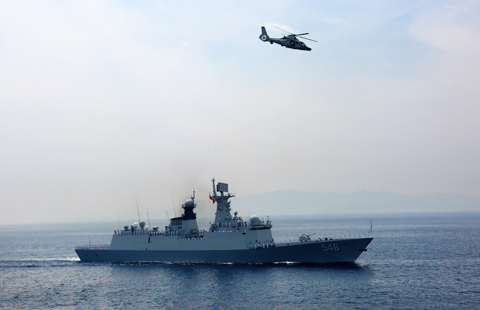New US spaceship set for Thursday test flight
Updated: 2014-12-04 10:05
(Agencies)
|
|||||||||||
CAPE CANAVERAL, Fla. - A new US spaceship designed to fly astronauts to Mars and other deep space destinations is poised to blast off on an unmanned test flight on Thursday.
A triple-booster Delta 4 Heavy rocket, built and flown by the Lockheed Martin Corp and Boeing Co joint venture known as United Launch Alliance, was cleared for its planned launch from Cape Canaveral Air Force Station at 7:05 a.m. EST (1205 GMT) Thursday, NASA said on Wednesday.
Perched atop the rocket, the biggest in the US fleet, is NASA's first Orion space capsule. It is due to make a 4-1/2-hour flight to test its heat shield, parachutes and other systems needed to ferry astronauts into deep space and return them safely to Earth.
Meteorologists predicted a 70 percent chance the weather will be acceptable for liftoff on a launch that is part of the US space agency's plan to land humans on an asteroid sometime around 2025 and on Mars about a decade later.
"Tomorrow is a giant day," NASA Administrator Charlie Bolden told reporters at the launch pad on Wednesday. "For the first time in more than 40 years this nation is going to launch a spacecraft intended to carry humans beyond low-Earth orbit. That's a big deal."
NASA's last human expedition beyond Earth was the final Apollo mission to the moon in 1972.
Flying the capsule without a crew allows NASA to aggressively test how well it fares beyond the protective environment of Earth's magnetic field and during a 20,000 mph (32,200 km/h) dive back into the atmosphere.
The rocket will take Orion about 3,600 miles (5,800 km) into space, some 15 times farther than where the International Space Station flies, before it plunges back to Earth.
Key events, such as the jettisoning of aerodynamic panels and launch escape system and the deployment of parachutes, will be immediately apparent. How Orion weathers other aspects of the flight will not be known until engineers retrieve recorded data from more than 1,200 sensors aboard the ship.
If all goes as planned, Orion, built by Lockheed Martin, will splash down in the Pacific Ocean off the coast of Mexico's Baja California peninsula. Two US Navy ships and other vessels will be standing by to retrieve the capsule.
Related Stories
US rocket explodes on liftoff in NASA's commercial spaceflight effort 2014-10-30 07:52
NASA is back at Mars 2014-09-22 11:10
Boeing, SpaceX win contracts to build 'space taxis' for NASA 2014-09-17 07:48
US needs to reexamine NASA's China exclusion policy 2014-06-05 09:19
Rising seas threatening NASA launch centers 2014-05-21 07:10
Today's Top News
HK protest founders turn themselves in
China to launch $8.13b fund to fight pollution
Capital mulls new building rules
154 'foxes' surrender before deadline
ICBC opens branch in London
US, EU leaders discuss potential action against Russia over Ukraine
Tolerance ends, HK chief vows
Nation 'ready for new era' of lower GDP growth rates
Hot Topics
Lunar probe , China growth forecasts, Emission rules get tougher, China seen through 'colored lens', International board,
Editor's Picks

|

|

|

|

|

|






